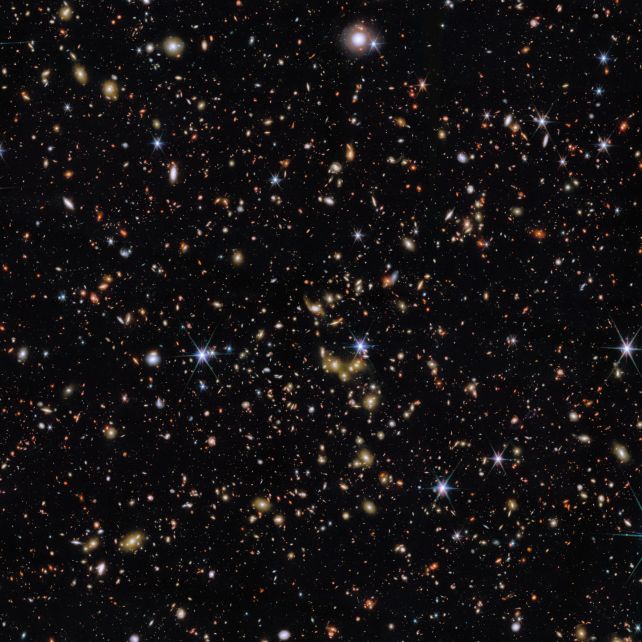The Universe's Largest Map Is Here—Explore the Cosmos Like Never Before 🚀
The James Webb Space Telescope (JWST) has just released the most ambitious space map ever created: COSMOS‑Web. Covering 98% of cosmic time, it catalogs almost 800,000 galaxies, eclipsing the famous Hubble Ultra Deep Field by orders of magnitude. Today, anyone can stargaze through its vast, interactive canvas—revealing the Universe's early structure with unprecedented clarity.
What Makes COSMOS‑Web So Revolutionary?
-
Vast Coverage, Unmatched Clarity
-
Spanning 0.54 square degrees—about the width of three full Moons—COSMOS‑Web is the largest survey ever by JWST (space.com).
-
It stretches across 13.5 billion years of cosmic history—covering nearly 98% of the Universe's 13.8-billion-year timeline (phys.org).
-
-
Sizeable Dataset & Deep Insights
-
Nearly 800,000 galaxies have been discovered—about 10 times more than predicted based on prior observations (space.com).
-
JWST revealed not just galaxies, but supermassive black holes invisible even to Hubble (phys.org).
-
-
Interactive & Public
-
The COSMOS team has shared all data, imaging, and an interactive online viewer—empowering scientists, students, and citizen astronomers worldwide (rit.edu).
-
A core goal: democratizing astronomy—letting diverse perspectives illuminate new discoveries .
-
Why COSMOS‑Web Changes Everything
🔭 Peering Into Cosmic Dawn
-
Thanks to JWST's infrared eyes and 6.5 m mirror (nearly three times Hubble’s), COSMOS‑Web detects faint, ancient light from when the Universe began clearing its cosmic fog (space.com).
-
The map reveals galaxies and massive black holes from as early as 400 million years after the Big Bang—formation models now scramble to keep pace (earth.com).
🧩 Seeing the Cosmic Web
-
This is not just about bright galaxies—it’s about mapping the interconnected cosmic ecosystem: galaxy clusters, voids, and dark matter frameworks .
-
Including these large-scale structures is key to understanding how galaxies evolve in context, rather than isolation .
📈 Data That Defies Expectations
-
The count of early galaxies is an order of magnitude higher than considered possible—a major puzzle for cosmologists (sciencedaily.com).
-
These findings may rewrite how we understand galaxy formation, pushing early star and black hole growth models to the limit.
The Math Behind the Map

-
JWST dedicated ~255 hours (plus overhead) to the survey—mapping in four infrared filters across 0.6 sq deg plus deeper mid-infrared coverage (perplexity.ai).
-
Imaging is combined with data from Hubble & ground-based telescopes, producing rich datasets complete with photometry, morphology, redshifts, and physical galaxy properties (arxiv.org).
A Community Effort for Discovery
-
Over 50 researchers from UC Santa Barbara, RIT, and more helped drive the survey (rit.edu).
-
Findings are published in Astrophysical Journal, Astronomy & Astrophysics, and arXiv repositories, covering galaxy growth, cosmic environments, and reionization bubble mapping (phys.org).
-
Tools include machine‑learning redshift estimators and refined photometric techniques, enabling precise physical property derivation .
What We’ve Already Discovered
-
Early Galaxy Clusters & Supermassive Black Holes
-
Clusters of galaxies and quasar-like black holes at extreme redshifts; deeper than once thought possible (phys.org).
-
-
Dense Structures & Cosmic Hinterlands
-
Evidence of cosmic filaments, voids, and groupings shaping how galaxies grow and interact (space.com).
-
-
Paradigm Shift in Galaxy Counts
-
Discovery of about 10x more galaxies from early epochs than expected—reshaping cosmological models (livescience.com).
-
-
Precision Mapping
-
With 37-band photometry, scientists can estimate galaxy redshifts and masses with unmatched accuracy (arxiv.org).
-
Your Guide to Stargazing the COSMOS Field
-
Head to the COSMOS‑Web interactive viewer and:
-
Zoom into individual galaxies across diverse ages and masses.
-
Search by redshift, galaxy type, or cluster membership.
-
Download raw data, catalogs, imaging: they’re free and public.
-
-
Educators can use this resource to inspire students, while astronomers craft new hypotheses and models.
-
Citizen scientists—your insight matters! Every eye helps unravel cosmic mysteries.
SEO Highlights at a Glance
-
Primary Keywords: COSMOS‑Web, JWST galaxy map, Universe’s largest map, early galaxies
-
Secondary Keywords: interactive space map, cosmic web, infrared deep field, democratized astronomy
-
Headers: Structured for readability and SEO flow
-
Internal Linking Hooks: Navigation, dataset access, background on JWST & cosmic dawn
Future Directions & Bigger Questions
-
Reconciling Models: The flood of early galaxies forces a rethink of models around star formation and galaxy assembly.
-
Reionization Mapping: Tracking massive hydrogen ionization bubbles via galaxy clustering.
-
Strong Gravitational Lenses: Preliminary studies (e.g., COWLS) reveal hundreds of lensing systems, opening the door to dark matter mapping (arxiv.org, sciencealert.com).
-
Galaxy Evolution: Ongoing efforts measure size vs. mass evolution from redshift 2 to 10, informing how structure scales over time (arxiv.org).
Final Reflection
COSMOS‑Web is more than a map—it’s a cosmic time machine and a scientific democratizer. With nearly 800,000 galaxies cataloged across most of the Universe’s history, it offers answers—yet deeper questions arise. It reshapes our cosmological narrative, challenges theoretical frameworks, and extends a global invitation for exploration.
Whether you're an astrophysicist, amateur astronomer, student, or curious observer, this map puts the entire cosmos within reach. Explore it now—and stargaze like never before.
Open Your Mind !!!
Source: ScienceAlert
